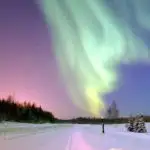Did you know that you can see the northern lights in Yellowknife, Canada?
Northern Scandinavia has been one of the most popular places to view the aurora for many years, but Yellowknife quickly became ‘the world capital of northern lights’.

Pin me.
We were planning to see this phenomenon someday in Iceland but never considered witnessing it in Canada. We found out about the northern lights in Yellowknife during our Rocky Mountains road trip, and we had to get there.
Before you head to see the northern lights in Yellowknife, there are few important things to know about them.
The Northern Lights, or Aurora Borealis name comes from ancient times, a blend of Aurora (the Roman Goddess of Dawn) and Borealis (meaning morning light coming from the North) in Latin.
Over time the lights had a different meaning to people who witnessed it:
the spirits of the dead, a window into the realm of the gods, fire breathed by dragons, even a bad omen marking the arrival of war or disease.
Here are our 5 things you need to know about the northern lights In Yellowknife:
1. You can’t view northern lights in Yellowknife year round

Most people don’t realise (we didn’t either), that during the summer the Yellowknife sky is simply too bright for aurora viewing.
Although the aurora occurs year round, Yellowknife is located in a high latitude; therefore in summer with almost 24hrs of daylight, it is just impossible to view the aurora.
2. Learn the best time to see northern lights in Yellowknife before your visit

The lights can be observed for up to 240 days a year when the sky is dark.
The best time to spot the colourful lights is from middle of August to the end of September and again from mid-November until mid-April.
We visited Yellowknife in mid-May and although two weeks before we arrived there were few days perfect for aurora viewing, we have seen none. We stayed up all night, but the sky didn’t get dark at all. The sun was setting 11 pm and rising again after 3 am.
3. You can’t predict the aurora in Yellowknife

The aurora usually appears on a dark, clear night anytime from 6 pm to 6 am.
The northern lights, resulting from forms of electromagnetic energy drawn to earth’s poles, change the atmosphere and cause the glow.
4. What are the main colours of northern lights in Yellowknife?

Auroral displays appear in many colours although pale green and pink are the most common. Shades of red, yellow, green, blue, and violet have been reported.
The unique colours, created by the Earth’s spectra of gases and the height in the atmosphere where the collision of particles from the sun and the Earth’s gases takes place can certainly create a spectacular show.
5. Know the best aurora viewing spots in Yellowknife

There is a lot of companies that provide guided ‘northern light experience’, but there is no reason why you can’t witness them on your own.
The general rule is: the further you get from city light, the higher chance you have to spot the northern lights in Yellowknife.
Here are some of the best places to view northern lights in Yellowknife:
Dettah Ice road – Get to School Draw Avenue and you will come across an entrance to the Dettah Ice Road.
Keep in mind that the Ice Road is only open in the winter and usually January to March.
Pilots Monument -Located in the centre of Old Town, Yellowknife up the hill often called the rock.
At the top of the road, you will find a parking lot and stairs that lead to the top of the monument. This spot gives you an excellent 360 view of Yellowknife and area
Parker Park – Situated Just off of Finlayson Drive in Yellowknife South, Parker Park.
It is a big open area making it a great place to spot the northern lights in Yellowknife city centre.
Prelude Lake – Prelude Lake Territorial Park is about 45 minutes from Yellowknife along the Ingraham Trail.
End of Ingraham Trail – At the end of the Ingraham Trail is Tibbitt Lake. In the winter it becomes the start of the ice road to the Diamond Mines.
There is a small parking lot. Keep in mind that we had no phone reception here.
You can view a live feed of the Aurora of Yellowknife and the forecast at Astronomy North’s website (AuroraMax). This is probably the best place to watch and monitor the aurora.
Here is a fantastic National Geographic video of northern lights in Yellowknife:
Make sure to check aurora forecast before heading up north.
If you are planning to travel the Rocky Mountains, read our ‘Rocky Mountain road trip guide’ covering every place worth seeing between Vancouver and Yellowknife.
Safe travels
Sabina and Steve
P.S. Don’t forget to pin our image for the future!

Pin me.
